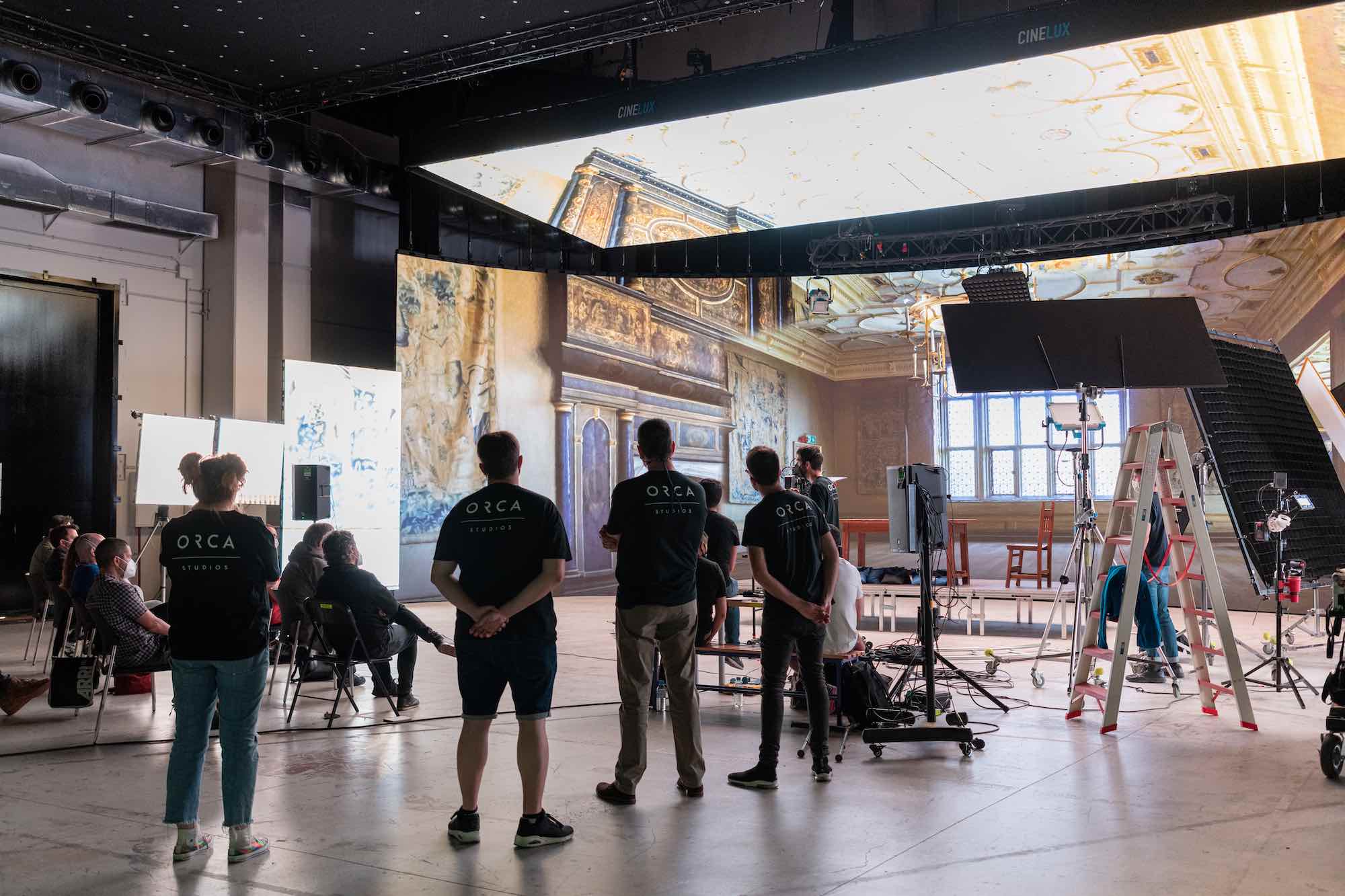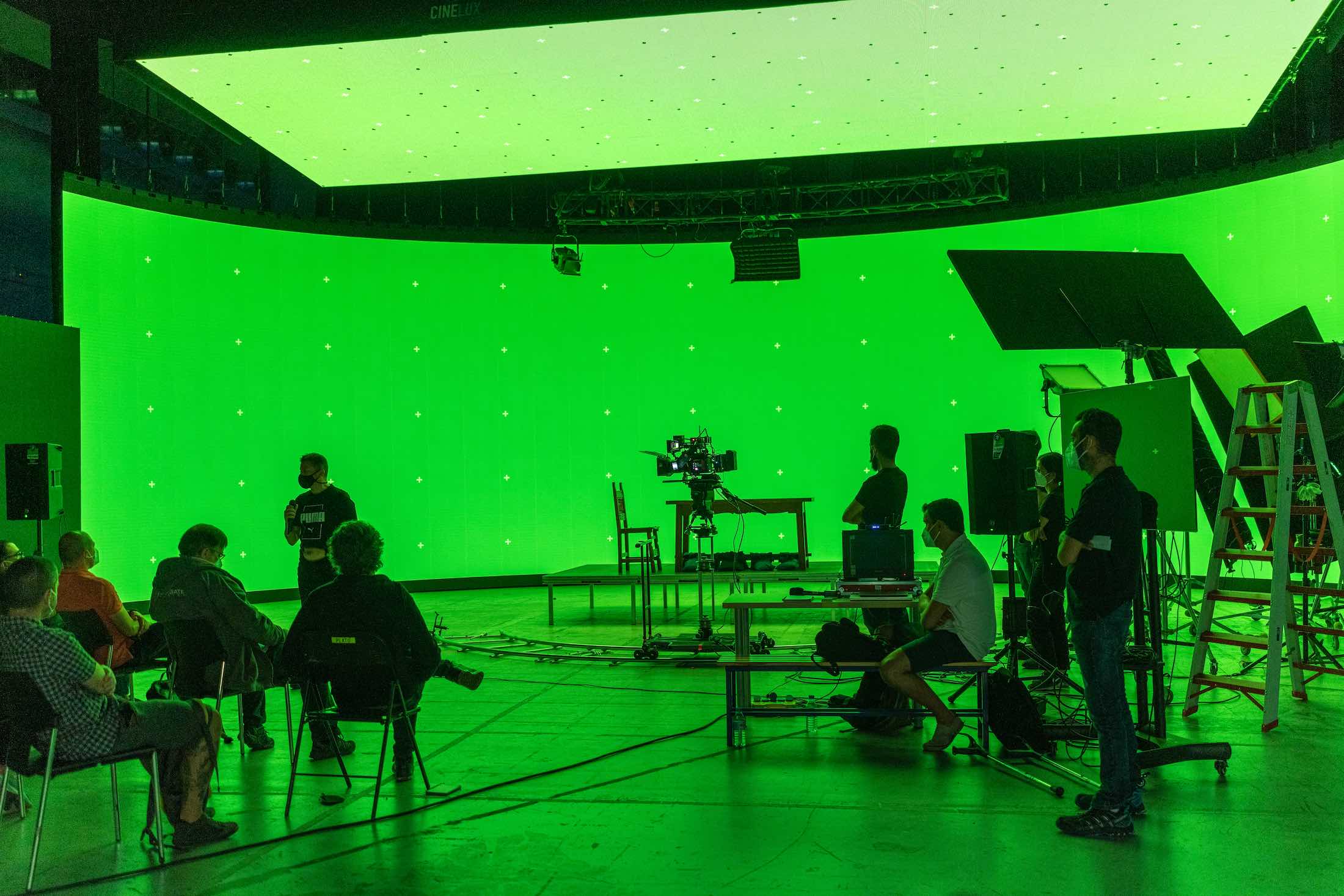The era of virtual production
Discover Orca Studios’ virtual production pipeline. We spoke to the studio about its in-house virtual soundstage and how ftrack Studio helps keep real-time projects on track, from stage to screen.
Virtual production pipelines offer studios a whole new way to create.
Orca Studios is one VFX house that has wholeheartedly embraced real-time and the benefits it introduces into the creative workflow. Indeed, Orca’s virtual production studio in Madrid houses a fully customizable virtual soundstage, including a high-resolution 100m² curved wall capable of displaying 1,000-nit HDR images calibrated towards each camera sensor. So whether shooting regular plates or more complex 3D environments that respond to camera motion, Orca is up to the job.
“In a traditional VFX pipeline, the heavy work falls at the end of production; you’re chained to the final edit, and if there are problems during the shoot that can’t be solved, they become an extra ‘problem’ for the post-production team,” explains Maria Tortosa, Head of Production. “A virtual production pipeline reverses the cycle; the VFX team is there from the start of production as, acting as the art department, they have to establish, decide, and create the environments needed for the shoot. The entire process is more fluid, and as a result, people can make decisions more quickly and efficiently. And this process can massively benefit all kinds of shows, from huge summer blockbusters to independent productions. That’s why we’re big advocates of virtual production at Orca.”
Orca is already reaping the benefits of virtual production as the company grows and takes on more projects—and ftrack has helped keep things on track as Orca navigates this increasingly complex and creatively rewarding work.

The benefits of a virtual production pipeline
Orca Studios was founded by producer Adrián Guerra in 2016 and was revamped in 2020. Guerra previously worked on films such as the Sundance favorite Buried and the psychological thriller Red Lights. When he started Orca, Guerra wanted to offer all the benefits of a regular VFX house, from pre-production to post, while pioneering new approaches in the then-emerging field of real-time technology.
Today, Orca’s offices are spread across Madrid—which houses the studio’s impressive LED volume—the Orca HQ at Las Palmas, and Barcelona, where Orca shares offices and collaborates with Nostromo Pictures, one of the leading film production companies in Spain.
“Orca was a full-service VFX and virtual production studio from its inception, built from the ground-up around innovative, bleeding-edge tech and run by a seasoned team of film industry professionals,” says Adrian Corsei, Head of Studio. “Today, we cover the full range of filmmaking, from pre-production, on-set supervision, and in-camera VFX to post-production, VFX supervision, and virtual production. We aspire to use our virtual production pipeline as much as possible for a wide range of projects and clients, alongside creating content using many other new and exciting technologies.”

Orca has certainly enjoyed swift and impressive growth thanks in part to the benefits proffered by real-time virtual production technology.
“A virtual production pipeline offers so many benefits over more traditional VFX pipelines, regarding both production flexibility and final project quality,” explains Corsei. “We have full control of weather and lighting conditions and can completely change the lighting effects in a scene within seconds. Also, as LED screens serve as the main lighting source the actors are lit by the screen itself, which produces more realistic results than a greenscreen setup. The light affects the stage and the actors in real-time in line to the camera’s movements and the sun’s position in the environment. We can also adjust the parameters of colorimetry to achieve the tones and saturation we want on set. All of this massively reduces the volume of work required from the VFX team in post.”
“ftrack Studio is a crucial part of Orca’s success. Its built-in planning, scheduling, and time-tracking helps us to maximize our capacity as a studio” Anca Bratu, Virtual Production Coordinator
Planning with ftrack
Orca’s approach has proven popular with many productions, and the studio’s project load now resembles its service offering: broad and varied. “Given our range of services, our projects vary in both size and time-frames—sometimes we’ll have six smaller projects on at once; at other times, we’ll have four larger, more involved projects,” says Corsei. “Most recently we delivered 400 VFX shots in just four weeks for an international production, which was a fun challenge.”

Given the unpredictability of what might come into the studio next and the adaptive nature of Orca’s virtual production pipeline, the team requires a robust organizational tool to ensure everything reaches the finish line at the right time.
“ftrack Studio is a crucial part of Orca’s success,” says Anca Bratu, Virtual Production Coordinator. “ftrack’s built-in planning, scheduling, and time-tracking, and its ability to predict the downtime of artists, helps us to maximize our capacity as a studio.”
ftrack Studio’s Overview tab, which details everything occurring on a single project, has proven particularly useful to Orca’s VFX producers. “Our producers use ftrack’s Overview tab to quickly skim through projects or view the entire studio schedule as a compiled view, all from one screen, which is a great way of working,” says Bratu. “They can also customize dashboards to show specific information about projects, which is hugely beneficial when clients or supervisors need to see a quick breakdown of that data.
“Another interesting thing we’ve done with ftrack Studio was to connect the software with the virtual production stage booking system, so there are no clashes when scheduling screen usage for different projects.”
Bratu and Orca’s producers also use ftrack Studio to track artist time, which helps when reporting on finished projects and bidding on new ones. “Features like this make work for Orca’s coordinators so much easier. They don’t need extra assistants to chase artists for information—ftrack Studio does that for them.”
ftrack Studio presents plenty of production tracking functionality out of the box, but the ftrack Python API also allows for bespoke customization if it’s needed. Orca Studios had some ideas and dived into the API, finding ways to fine-tune the software toward its unique, studio-specific workflows.
“The ability to customize ftrack Studio and align it with our pipeline has saved Orca Studios a ton of time,” says Bratu. “We have worked with the ftrack developers, who are super helpful, to create customized tools that sped up and automated many things our artists need to do, which was vital in saving us time and money. For example, using ftrack Studio, we can now easily ingest the Tracked Camera from our on-set tracking system into the pipeline for artists to use in Houdini, Maya, or Nuke.”
A customized login process has also helped Orca stay secure, which was a must in the era of remote workflows enforced by COVID-19.
“At Orca, we connect with a lot of people around the world to create and deliver our work,” says Bratu. “Currently, we’re working with artists in multiple time zones, including Spain, Los Angeles, and Russia. Many of our artists log in via our in-house virtual machine systems to connect with our on-set virtual production technicians in Barcelona or Madrid.
“This login process is made possible thanks to our customization of ftrack. Once logged in, data can flow from the virtual production stage straight to editorial, who edit the content and then publish it through our in-house systems and ftrack Studio. We can then track the extra work required from post-production.
“With multiple studios in various locations, effective collaboration can only come through a cloud-based infrastructure centralized on a local server. It really is essential to have a tool like ftrack making these things happen.”
A view on the future
Virtual production is not a trend or a fad; as Orca Studios continues to prove, it’s an important new step in filmmaking, enabling the creation of exciting new visuals in a fraction of the time offered by traditional, linear workflows.
For Bratu, real-time and virtual production are the future—adopting them just requires a different way of looking at things. “The production schedule on a virtual shoot puts part of the weight at the start of the chain—the work has to be accomplished upfront,” she says. “The main challenge is to educate the industry on how to make VFX choices earlier in production. From there, it’s all about staying on top of things as you would on any other production—and ftrack is the tool that makes that happen.”
Source:FTRACK

熱門頭條新聞
- Farming Simulator Announces FarmCon 2025
- 11th Duhok International Film Festival Winners Announced
- Still There Launches on Epic Games Store with Special Discount!
- Announcing Xenopurge – A Real-Time Tactics Game Inspired By Aliens
- Alibaba Sells Gao Xin Retail for HK$13.1 Billion
- “Paddington in Peru “, a Live-Action Animated Adventure Comedy Film
- Grand Prizes for “Beautiful Man” and “Memoir of a Snail” at Cinanima 2024
- FragPunk’s March 6th 2025 Release Date Revealed at The Game Awards
